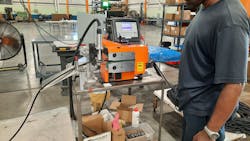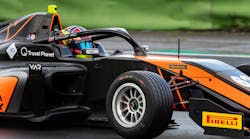Latest from Plant Operations
Caterpillar Feeder Speeds Tube and Profile Production at Eagle Elastomers
Adam Hines has been in the elastomer business for a long time. The process technician at Eagle Elastomers, which makes fluoroelastomer and perfluoroelastomer tubing for a wide range of markets, has had a front-row seat to see the shifting tides of the industry. One such change has been the trend towards larger tubing and profiles, and the desire to mark lot numbers, batch numbers, and other information onto the products. Eagle Elastomer uses an inkjet device to spray information on materials instead of stamping them, although internally they still refer to this process as stamping. “More people are wanting things imprinted now with manufacturing dates and lot numbers whereas before, it was just specific customers,” Hines explained. Over the last decade, this shift in requests and orders for larger-sized projects, coupled with accountability in marking has grown to become the norm, creating a huge headache for Hines.
Getting Out of a Pinch
Eagle Elastomer’s machine for marking profiles and tubing previously used a pinch wheel feed system. This was a great setup for smaller tubes but for larger tubing and exotic-shaped profiles the impressions became less accurate and straight, producing less than desired results. “You get to those bigger ones, and its (pinch) wheels just aren’t strong enough to hold it. It’s very cumbersome,” Hines explained. Additionally, the pinch wheel system required operators to stand next to it and continually guide the tubing through the system. As the need for stamping larger materials grew, Hines was tasked with finding a solution. Thankfully he knew who to call.
Several years ago, Hines worked with Versa Machinery to automate the company’s tube and profile cutting process from 150 pieces per minute to more than 3,000. With that success in mind, Hines reached back to his contact at Versa for their thoughts on the project. Turns out that Versa’s 9-in. CM-22 Caterpillar drive could be the centerpiece that Hines could design his entirely new marking system around. From concept to design to finished machine, the process took Hines about a year to accomplish. He’ll be the first to tell you that it was worth the wait.
Driving Better Results
Eagle Elastomer designed a new imprinting system to handle larger requests but what they ended up with could handle all of their marking needs. After trading CAD concept drawings back and forth with Versa, Hines was able to actualize his vision for how his new workflow could come to life. “We can use it on the small stuff as well as all the way up to the large stuff,” explained Hines. This gave the production team additional flexibility, allowing impression orders of all shapes and sizes including accommodating up to 1.500-in. profile requests. Beyond handling larger sizes, Hines saw his overall marking capabilities increase with their Versa Caterpillar system. “We’ve got it set up where the stamping can be imprinted straight up and down or flipped 90-deg. If you’re trying to stamp something but you don’t want the Caterpillar belt to hit the impression, it shoots to the side.” Previously the team’s pinch wheel system could only mark straight down, or at a 20-deg. angle. Additionally, cut length feeds can now be fed while the machine is still rolling for certain tubing and cord sizes. All-in-all the Versa system’s additional functionality not only increases Eagle Elastomer’s marking productivity but their project capabilities as well.
The process at Eagle Elastomer was well defined but offered Hines some room for improvement. Materials are extruded, then vulcanized, then post cured, and hit with a final finish for inspection before cleaning and then any customer requirements such as cut lengths and imprinting. In designing the new workflow, Hines added in some features to allow the Versa caterpillar and the Video Jet to work in unison. Using an encoder wheel affixed to the Versa caterpillar main drive axle, Hines queued the Video Jet to its programmed distance between impressions and affixed an electric eye to queue the system when to spray. This prevented continuous imprinting while the encoder wheel was turning and made the marking process easier for employees.
Don’t Feed the Caterpillar
Previously in the company’s pinch wheel system, operators were handcuffed to the machine to manually feed the system. Now (with the caterpillars increased gripping surface) operators don’t have to guide materials through the Video Jet and can instead immediately start coiling up the tubing on the other end. “The fact that the operator can walk away and start doing the coil up eats away at the time that it normally would take for him to stamp an entire product and then start doing coil up afterward. He’s basically able to do two things at the same time,” said Hines. While an official time study on the change hasn’t happened yet, Hines estimates the new Versa system is working 25 to 50% faster than before.
The Versa Caterpillar system also provided Hines and his team with more safety features than their pinch wheel system. “The nice thing about the Caterpillar is there’s less of a pinch point. With the pinch wheels, the wheels are pretty much in the open.” With the previous pinch wheel system design, the main wheel components were exposed while employees manually fed the system. Now with the caterpillar system, the wheels are embedded in the system and the larger gripping surface means operators don’t have to get as close to the wheels. Eagle Elastomer set out to increase their marking capabilities, but they were more than happy to have more safety guarding in place for their employees as well.
How It Works
Versa caterpillar pullers provide uniform pressure over the entire traction length, exerting greater pulling force without product deformation. The belt configurations range from 2 W X 9 in. L (50 x 230 mm) to 4 X 18 in. (100 x 460 mm). All Versa pullers are fitted with a handwheel or optional pneumatic operation of the belt booms along a constant centerline to make repeatable setup almost instantaneous.
Versa’s caterpillar puller assemblies are available in either a right-to-left or left-to-right configuration to fit into any workflow. The caterpillar drive also can be customized with optional air opening/closing, gear or belt drive, and with either OSHA or CE style guarding. The non-motorized puller assembly can operate at speeds up to 550 FPM.
By partnering once again with Versa Machinery to upgrade their imprinting process, Eagle Elastomer was able to increase productivity, output, and safety. Safe to say this is a deal Hines is happy to put his stamp on.
Versa Machinery is a manufacturer of automated downstream equipment for the plastic and rubber extrusion industries. For 70 years they have designed and built de-reelers, cutters, pullers, cutter/puller systems, and takeaway conveyors. In addition to an extensive lineup of standard products, they can customize solutions to specific applications.















